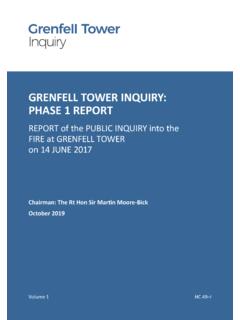Transcription of Resilience and disaster risk reduction ... - Copernicus.org
1 Natural Hazards Open Access Nat. Hazards Earth Syst. Sci., 13, 2707 2716, 2013. and Earth System Author(s) 2013. CC Attribution License. Sciences Resilience and disaster risk reduction : an etymological journey D. E. Alexander Institute for Risk and disaster reduction , University College london , london , UK. Correspondence to: D. E. Alexander Received: 18 February 2013 Published in Nat. Hazards Earth Syst. Sci. Discuss.: 17 April 2013. Revised: 23 August 2013 Accepted: 6 October 2013 Published: 5 November 2013. Abstract. This paper examines the development over histor- 1 Introduction ical time of the meaning and uses of the term Resilience . The objective is to deepen our understanding of how the term The purpose of this paper is to clarify some issues regarding came to be adopted in disaster risk reduction and resolve the ways in which the word Resilience is used in the field of some of the conflicts and controversies that have arisen when disaster risk reduction (DRR).
2 The term has become fashion- it has been used. The paper traces the development of re- able in recent years, but the multitude of interpretations and silience through the sciences, humanities, and legal and polit- usages to which it has been subjected has led to confusion. ical spheres. It considers how mechanics passed the word to Moreover, few scholars seem to be aware of the term's long ecology and psychology, and how from there it was adopted and distinguished history, yet this clearly has a bearing on by social research and sustainability science. As other au- how it is employed in its modern context. thors have noted, as a concept, Resilience involves some po- The specific aims of the paper are as follows: tentially serious conflicts or contradictions, for example be- to trace the history of the term Resilience in order to tween stability and dynamism, or between dynamic equilib- illuminate its development and give the modern usage rium (homeostasis) and evolution.
3 Moreover, although the re- some historical depth and continuity;. silience concept works quite well within the confines of gen- eral systems theory, in situations in which a systems formula- by means of a selective review of the literature, to in- tion inhibits rather than fosters explanation, a different inter- vestigate some of the ways in which the modern adop- pretation of the term is warranted. This may be the case for tion of the term could be problematic;. disaster risk reduction , which involves transformation rather than preservation of the state of the system . The article to examine the rift between academic and practical concludes that the modern conception of Resilience derives work in DRR and to suggest a way in which it might benefit from a rich history of meanings and applications, but be healed;. that it is dangerous or at least potentially disappointing to to attempt a reconciliation between some divergent read to much into the term as a model and a paradigm.
4 Views of what Resilience means. The accumulation of articles and books on Resilience in its Sagitta in lapidem numquam figitur, interdum various contexts is now so large that a full review of how resiliens percutit dirigentem. the term is used is beyond the scope of this article. However, An arrow never lodges in a stone: often it recoils upon its some general lineaments can be traced, starting with the ori- sender. St John Chrysostom (ca. 347 407), Archbishop of gins and early use of the word. Constantinople 2 The historical etymology of the term Resilience The word Resilience , together with its various derivatives, has a long and diverse history. In order to gain a deeper and more Published by Copernicus Publications on behalf of the European Geosciences Union. 2708 D. E. Alexander: Resilience and disaster risk reduction : an etymological journey to shrink or contract . Quintillian (Marcus Fabius Quintil- ianus, Istitutio Oratorio, 12, ) used it in the sense of to avoid 2.
5 However, the most common uses were to de- scribe leaping, jumping or rebounding. Pliny the Elder (Nat- ural History , ) used the term to refer to the leaping of fleas and frogs. Cicero, in his Orations, used it in the sense of rebounding3 . This meaning was strongly perpetuated in the proverbs of St. Jerome (AD 347 420)4 . It is of note that many of these uses had negative connotations the rebounding was not a happy result, or the subject person recoiled in his desire to dissociate himself from what was going on. Much later, the term passed into Middle French (r siler), in which it came to mean to retract or to cancel , and then it migrated across the Channel into English as the verb resile, a word that appears in the State Papers of King Henry VIII. in 1529 and evidently relates to his troubles with his first queen, Catherine of Aragon (1485 1536). Here, it was used again in the sense of retract , return to a former position.
6 Or desist 5 . Canonbury Tower (Fig. 1) was constructed in the North london in 1509 on the site of Roman remains. The builder was William Bolton, Prior of St Bartholomew, the forerun- Fig. 1. Canonbury Tower, North london (photo: author). ner of the eponymous london hospital. In 1537, when Henry VIII dissolved the monasteries, the tower passed to Thomas Cromwell, First Earl of Essex (1485 1540). It was later sold mature perspective on the term and its many shades of mean- to John Spencer, Lord Mayor of london . In 1610 it passed to ing, I believe its modern evolution needs to be reconnected the Earl of Northampton, who for the period 1616 26 leased to its early history. 2 ..we must press the points that we see commend themselves Many students of the robustness of people, objects and systems believe that Resilience was coined by C. S. Holling to him, and draw back from those which are ill-received , (Marcus in his landmark 1973 paper on systems ecology (Holling, Fabius Quintilianus, Istitutio Oratorio, 12 ).)
7 3 ..when you strike upon such a rock that you not only see the 1973). For example, Berkes (2007, p. 286) wrote, Origi- accusation rebound back from it, but perceive that every suspicion nally developed as an ecological concept, Resilience is being falls upon you yourselve . M. Tullius Cicero, For Sextus Roscius of applied to coupled human-environment systems. Djalate et Ameria ( ). al. (2011, p. 3) wrote the concept of Resilience was orig- 4 See opening quotation, which has also been attributed to St. inally developed in the field of ecology . Goldstein and Jerome. Brooks (2006, p. 3) were a little more generous with time 5 Stephen Gardiner (1483 1555), secretary to Cardinal Wolsey when they stated that The study of Resilience traces its roots and future Bishop of Winchester, writing at Woodstock on back a scant 50 years . In reality, the word has a very much 1 September 1529 to Thomas Wolsey (1473 1530): longer history (OED, 2013).
8 It stems from resilire, resilio, Lord Chancellor: Your Grace therfor his most harty Latin for bounce hence the idea of bouncing back . thankes; trusting that Your Grace hath in all circum- (Manyena et al., 2011). stances soe pro[ceeded], as, if the Quene wold her- The etymology of resilire, resilio is unknown, which in- after resile and goo b[ack from] that, she semeth nowe dicates that it was probably a part of standard Latin as to be contented with, it shuld [not be] in her power soo much as any such thing existed in Classical times, and was to doo; but that this acte, doon [before] Your Grace thus a word used occasionally by accomplished men of let- and the Cardinal Campegius, ma[y be] prejudicial to ters. The term appears in the writings of Seneca the Elder, her here, at Rome, or elleswhere, [by the] letting and Pliny the Elder, Ovid, Cicero and Livy. In his collection of empeching of further prosecution, [and of] any cita- imaginary legal cases, Seneca used the term, in the sense of tion or processe impetrate, or to be [impetrate], by her, to leap 1.
9 In the Metamorphoses ( ), Ovid used it as or her proctours, herafter.. Henry VIII State Papers, 1. page 343. State Papers Published under 1 ..quanto minus quam in templum resiliuit? Annaei Senecae Or- the Authority of his Majesty's Commission: King Henry the Eighth, atorum et rhetorum sententiae divisiones colores. Seneca the Elder, 1830 1852. Vol. 1: Part I: Correspondence between the King and Adolf Gottlieb Kiessling, in aedibus B. G. Teubneri, Leipzig, 1872. Cardinal Wolsey, 1518 1530, CLXXX; p. 343. Nat. Hazards Earth Syst. Sci., 13, 2707 2716, 2013 D. E. Alexander: Resilience and disaster risk reduction : an etymological journey 2709. Fig. 2. Resilience in the Sylva Sylvarum of Francis Bacon. it to Sir Francis Bacon, Attorney General of England (Glin- ert, 2012, p. 359). Here, Bacon is credited with devising the modern scientific method, or at least the inductive version of it.
10 Herein, he was also responsible for the first known scien- tific use in English of the word Resilience . Bacon was unusual for his time in that he wrote in both Latin and in English, the latter for a greater divulgation of his work. Hence, there was bound to be some transfer of ter- minology between the two languages. In 1625 he published a compendium of writings on natural history, the Sylva Syl- varum. In this, during a musing on the strength of echoes, he first used the term Resilience (Bacon, 1625, p. 245, Fig. 2). In the late sixteenth century, the term seemed to have en- joyed greater use by the Scottish intelligentsia than by its English counterpart, and it became interwoven into the Scots dialect. Although resile faded from use in the 1700s, ever since then it has periodically been revived by those authors who like to make use of anachronisms. The first known dictionary definition of Resilience comes from the Glossographia compiled by the lawyer and anti- Fig.





